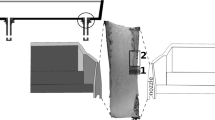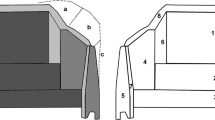Results of a comprehensive study of the material composition and microstructure of 20 skull samples taken after blowing out AO EVRAZ NTMK blast furnace No. 6 are provided. More than 30 mineral and metal phases of different chemical classes are diagnosed in skull samples. Unlike the skull of blast furnaces of other metallurgical plants (NLMK, ZSMK), NTMK blast furnace skull has an abnormally high content of titanium, zinc, and vanadium compounds, as well as heavy non-ferrous metals and sulfur. On the basis of detailed petrographic analysis, five structural and genetic types (versions of composition and origin) of the skull are identified. Skull versions contain a large amount of grenal, which is dominated by refractory compounds of titanium and vanadium carbonitrides of the general formula (Ti, V)(C, N).









Similar content being viewed by others
Notes
Carbon and SiC do not have a melting temperature as a result of direct conversion during heating into a gaseous state (sublimation).
In future the abbreviation TVCN is adopted.
References
C. R. Hubbard, E. H. Evans, and D. K. Smith, “The reference intensity ratio for computer simulated powder patterns,” J. Appl. Cryst., 169(9), 169 – 174 (1976).
G. I. Gazaleeva, “Development of technology for titanium magnetite, prospects for extensive use within Russia and the CIS, and comprehensive raw material use,” Proc. congress with international participation and conference of young scientists “Fundamental research and applied development of processing and utilization of technogenic formations, Technogen-2019”, UrO RAN, Ekaterinburg (2019).
L. F. Borisenko, M. B. Bordaevskaya, V. V. Burkov, et al., (V. I. Smirnov, editor) Ore Deposits of the USSR, in 3 Vol. Vol. 1 [in Russian], Nedra, Moscow (1974).
L. N. Ovchinnikov, Economic Minerals and Metallogeny of the Urals [in Russian], Geoinformark, Moscow (1998).
V. L. Yakovlev, Yu. V. Laptev, and A. M. Yakovlev, “Procedure for measuring the quality characteristics of the Gsevogor deposit of titanium magnetite ores,” Gorn. Inform. Annal. Byul., No. 11, 286 – 296 (2015).
V. V. Filippov, V. S. Rudin, A. Yu. Chernavin, et al., “Study of conditions of grenal formation during smelting Kachkanar GOK titanium magnetites,” Stal’, No. 5, 15 – 19 (2000).
D. Bergsma and R. J. Fruehan, “Fundamentals of titanium-rich scaffold formation in the blast furnace heath,” Ironmaking Conference Proceedings, 297 – 312 (2001).
V. A. Gostenin, A. L. Sibagatullin, V. P. Mavrov, et al., “Study of carbonitride skull formed in a hearth and bosh,” Stal’, No. 2, 29030 (2007).
B. I. Emlin and M. I. Gasik, Handbook for Electrothermal Processes [in Russian], Metallurgiya, Moscow (1978).
G. V. Samsonov, Refractory Compounds: Handbook for Properties and Applications [in Russian], Metallurgizdat, Moscow (1963).
D. S. Belyanki, B. V. Ivanov, and V. V. Lapin, Engineering Stone Petrography [in Russian], Izd. AN SSSR, Moscow 91952).
V. A. Perepelitsyn, Bases of Technical Mineralogy and Petrography [in Russian], Nedra, Mosc0ow (1987).
V. I. Kumanin (editor), Metallurgical Dictionary [in Russian], Russkii Yazyk, Moscow (189).
A. M. Kaverzin, V. G. Shchipitsyn, A. V. Vashchenko, et al., “Study of skull and lining in the hearth of blast furnace No. 2 AO EVRAZ ZSMK (Communication 2),” Chern. Met. Byul. Nauch. Ékon. Inform., No. 8, 17 – 29 (2018).
A. M. Kaverzin, V. G. Shchipitsyn, A. V. Vashchenko, et al., “Study of skull and lining in the hearth of blast furnace No. 2 AO EVRAZ ZSMK (Communication 1),” Chern. Met. Byul. Nauch. Ékon. Inform., No. 9, 9 – 24 (2018).
I. F. Kurunov, A. S. Bliznyukov, V. N. Titov, et al., “Study of the composition and structure of the hearth skull BF No. 6 NLMK (Communication 1),” Chern. Met. Byul. Nauch. Ékon. Inform., 75(2), 166 – 181 (2019).
I. É. Shepetovskii, A. G. Shalygin, M. R. Sadradinov, et al., “Study of the composition of skull in the blast furnace hearth of the Kosogor metallurgical plant smelting ferromanganese using schungite (Communication 1),” Chern. Met. Byul. Nauch. Ékon. Inform., 75(4), 432 – 447 (2019).
V. A. Perepelitsyn, A. S. Freidenburg, and I. N. Sorokin, “Some processes of skull formation in a blast furnace shaft,” Ogneupory, No. 2, 39 – 42 (1976).
Author information
Authors and Affiliations
Corresponding author
Additional information
Translated from Novye Ogneupory, No. 7, pp. 11 – 20, July, 2020.
Rights and permissions
About this article
Cite this article
Perepelitsyn, V.A., Zemlyanoi, K.G., Mironov, K.V. et al. Mineralogy and Microstructure of Skull Versions in AO EVRAZ NTMK Blast Furnace No. 6. Refract Ind Ceram 61, 364–373 (2020). https://doi.org/10.1007/s11148-020-00488-y
Received:
Published:
Issue Date:
DOI: https://doi.org/10.1007/s11148-020-00488-y




